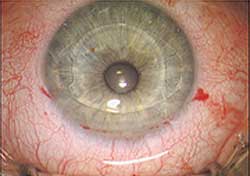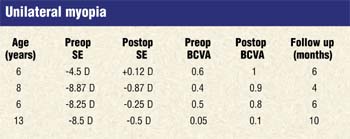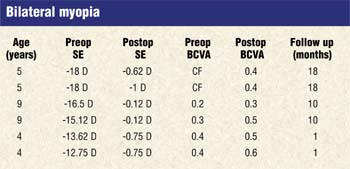Phakic IOL in pediatric patients shows encouraging results
In young patients who are intolerant to glasses and contact lenses, surgery can be a means to avoid irreversible amblyopia.
Managing amblyopia in pediatric patients means providing the best results in both present and future vision.
Amblyopia, defined as a difference of visual acuity of two lines between the two eyes, affects 2.6% of the population. Its major causes are strabismus and anisometropia. It is known that anisometropia exceeding 3 D leads to amblyopia in half of all cases.
In most patients, spectacle wear plus patch occlusion allows total visual recovery, or at least a significant gain in visual acuity. However, recurrent amblyopia is not rare, especially in cases of high anisometropia. In these cases the quality of optical correction plays an important role. Unfortunately, contact lens wear in pediatric patients comes up against several difficulties including intolerance, infectious risk and high cost.
Toward a surgical solution
These reasons have led several authors to consider refractive surgery in pediatric patients using LASIK, photorefractive keratectomy (PRK) or posterior chamber phakic IOLs in amblyopia management. However, these indications remain rare, as demonstrated by the small number of cases reported in the literature.
|
|
Refractive surgery in the management of amblyopia should be carefully approached. The unique features of the pediatric eye in its anatomic, functional and neurosensory development should be considered. The arguments against surgery are the fear of compromising visual acuity with immediate and long-term potential complications and the child’s refractive evolution toward progressive myopia. The arguments in favor of surgery are the hope to improve visual function and the good functional results to date of IOL implantation in pediatric cataracts.
Although keratorefractive procedures such as LASIK and PRK have been shown to be safe and predictable and to avoid the complications of intraocular surgery, their nonreversible refractive effect reduces their appeal in growing eyes in which refractive power will change throughout adolescence.
Phakic anterior chamber angle-supported IOLs, whose stability depends on lens size and the suitability of the anterior chamber diameter, do not seem indicated due to the growth of the eye. For the same reason, the use of posterior chamber phakic IOLs, whose stability is ensured by a proper match between IOL and sulcus diameter, is not recommended.
Among phakic refractive IOLs, Ophtec’s Artisan IOL appears to be a reasonable compromise. Its stability, due to its iris fixation, is less dependent on ocular growth than those of the other phakic lenses. Moreover, the refractive effect of the lens is reversible or adjustable by explantation or exchange of the IOL, and it allows correction of high ametropia.
To date, the Artisan has demonstrated good predictability and safety, although the risk to the endothelium remains a concern especially in young eyes and must be thoroughly studied in the long term. That is why patient selection has to be made carefully.
Patient selection
The indications for performing refractive surgery in pediatric patients are either unilateral amblyopia due to anisometropia or bilateral amblyopia related to high bilateral ametropia.
Our series of cases included 14 eyes of 10 children. These were patients with myopic or hyperopic amblyopia. Six of them had unilateral anisometropic amblyopia and four had bilateral high ametropia.
Surgery is considered only in patients with recurrent amblyopia who are contact lens-intolerant. In unilateral cases, amblyopia is always treated with patch occlusion.
The preoperative follow-up generally exceeds several months. It includes repeated refractive measurements under cycloplegia with cyclo-pentolate or atropine, orthoptic examination, electrophysiological testing in order to eliminate retinal or optic nerve disease and an endothelial cell count with specular microscopy.
Surgical procedure
The surgical procedure is essentially the same as used in adults. The operation is performed under general anesthesia, and the IOL is inserted through a 5.2- to 6.2-mm clear corneal incision using Healon GV (sodium hyaluronate, Pharmacia). The iris enclavation must be done firmly with a fold of the iris tissue thick enough to keep the lens from coming off. The risk of this is greater in children than in adults due to the risk of eye rubbing and ocular trauma. An iridotomy is made to prevent pupillary-block glaucoma.
Despite this surgery’s similarity to the adult procedure, only well-trained surgeons should perform it in pediatric patients.
Postoperative management includes regular specular microscopic examinations of the corneal endothelium, and of course the treatment of amblyopia must be carried out as long as it is necessary.
Results
In our cases of unilateral myopia, all four patients improved their distance visual acuity, even the older one. The refractive result is very predictable. In all patients, questioning demonstrates subjective improvement in daily activities, especially at school and in sports.
Of the two patients with unilateral hyperopia, one had visual acuity improved by two lines. The other one had the same distance vision as pre-operatively, but the near vision improved by two lines. This child has discontinued patch occlusion.
In the cases of high bilateral myopia (six eyes), the patient age is younger, the myopia higher and improvement of visual acuity is present in all eyes. But the most important result is the improvement in quality of life.
One other patient had preoperative bilateral hyperopia, and improvement of visual acuity has been noted at 1 year.
The use of the Artisan IOL in phakic eyes in the management of refractive amblyopia shows encouraging short-term results. Improvement in visual acuity seems more important in myopic amblyopia than in hyperopic eyes. However, all the children have improved in social and psychological aspects.
Still, surgery is only one step, and the treatment of amblyopia must be carried out with spectacle prescription as well as patch occlusion if necessary.
Currently there is limited experience with pediatric refractive surgery and a lack of knowledge regarding long-term issues of refractive surgical procedures in children’s eyes. Therefore, we think that the indication for refractive surgery is limited to amblyopic cases in which failure of regular treatment in patients who cannot wear glasses or contact lenses will lead to irreversible amblyopia.
|
|
For Your Information:References:
- Jean-Michel Bosc, MD, can be reached at Clinique Sourdille, 3 place Anatole France, 44000 Nantes, France; +(33) 2-51-77-10-50; fax: +(33) 2-51-77-16-88; e-mail: jmbosc@aol.com.
- For information on the Artisan phakic IOL, contact Ophtec USA, 6421 Congress Ave., Suite 112, Boca Raton, FL 33487 U.S.A.; +(1) 561-989-8767; fax: +(1) 561-989-9744; e-mail: ophtecusa.aol.com; Web site: www.ophtec.com.
- Attebo K, Mitchell P, et al. Prevalence and causes of amblyopia in an adult population. Ophthalmology. 1998;105:154-159.
- Lesueur L, Chapotot E, et al. La predictibilite de l’amblyopie chez l’enfant amétrope: A propos de 96 cas. J Fr Ophthalmol. 1998;21:415-424.
- Agarwal A, Agarwal A, et al. Results of pediatric laser in situ keratomileusis. J Cataract Refract Surg. 2000;26:684-689.
- Singh D. Photorefractive keratectomy in pediatric patients. J Cataract Refract Surg. 1995;21:630- 632.
- Nano HD Jr, Muzzin S, Irigaray F. Excimer laser photorefractive keratectomy in pediatric patients. J Cataract Refract Surg. 1997;23:736-739.
- Alio JL, Artola A, et al. Photorefractive keratectomy for pediatric myopic anisometropia. J Cataract Refract Surg. 1998;24:327-330.
- Lesueur LC, Arne JL. Phakic posterior chamber lens implantation in children with high myopia. J Cataract Refract Surg. 1999;25:1571-1575.
- BenEzra D, Cohen E, Karshai I. Phakic posterior chamber intraocular lens for the correction of anisometropia and treatment of amblyopia. Am J Ophthalmol. 2000;130:292-296.
- Budo C, Hessloehl JC, et al. Multicenter study of the Artisan phakic intraocular lens. J Cataract Refract Surg. 2000;26:1163-1171.
- Menezo JL, Cisneros Al, Rodriguez-Salvador V. Endothelial study of iris-claw phakic lens: four year follow-up. J Cataract Refract Surg. 1998;24:1039-1049.
- Fechner PU, Singh D, Wulff K. Iris-claw in phakic eyes to correct hyperopia: preliminary study. J Cataract Refract Surg. 1998;24:48-56.





